The Economics and Statistics Division maintains archives of previous publications for accountability purposes, but makes no updates to keep these documents current with the latest data revisions from Statistics Canada. As a result, information in older documents may not be accurate. Please exercise caution when referring to older documents. For the latest information and historical data, please contact the individual listed to the right.
<--- Return to Archive
For additional information relating to this article, please contact:
April 30, 2020EMPLOYMENT, EARNINGS AND HOURS, FEBRUARY 2020 
Nova Scotians' average weekly earnings (including overtime, seasonally adjusted) decreased 0.7 per cent (-$6.45) from January 2020 to $926.76 in February 2020. Average weekly wages were up 4.5 per cent compared with February 2020. Canadians' average weekly wages decreased 0.3 per cent month to month ($1,045.86 in February) and were 3.7 per cent higher than they were a year ago.
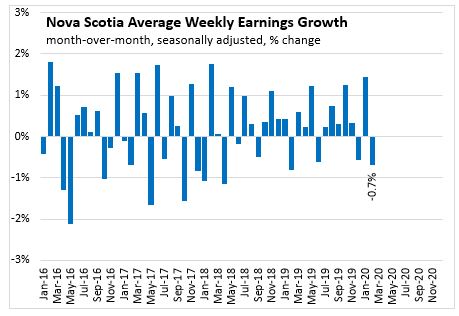
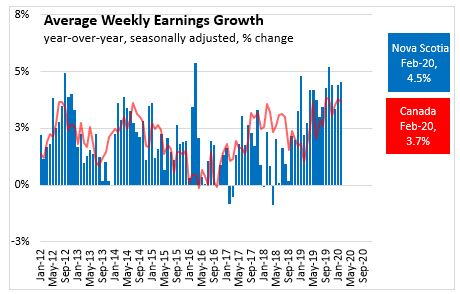
Changes in average weekly earnings reflect wage growth, changes in the composition of employment by industry/occupation/experience, and average hours worked per week.
Across the country, there are monthly decreases in provinces lead by Nova Scotia (-0.7 per cent), Quebec (-0.6 per cent), Newfoundland and Labrador, and British Columbia (-0.5 per cent). Compared to the previous month, there were monthly increases in three provinces, Manitoba (+0.8 per cent), Saskatchewan (+0.7 per cent), and Prince Edward Island (+0.6 per cent).
Compared to a year ago, average wages are higher in all provinces, with the largest increases in percentage terms reported in British Columbia (+4.8 per cent), Prince Edward Island (+4.6 per cent), Nova Scotia (+4.5 per cent), New Brunswick and Quebec (+4.2 per cent). The slowest year-over-year growth in average weekly earnings was observed in Manitoba (+1.0 per cent) and Newfoundland and Labrador (+2.5 per cent).
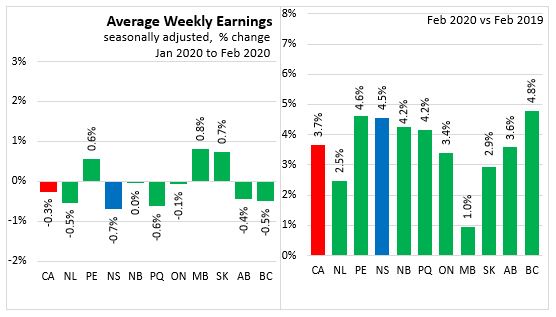
Comparing the first two months of 2020 with the same period in 2019, average weekly earnings have increased 4.5 per cent in Nova Scotia. Nationally, average weekly earnings have increased 3.7 per cent year-to-date.
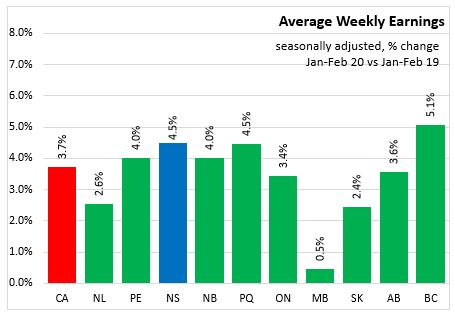
In January-February 2020 (compared to January-February 2019), average weekly earnings are up 4.0 per cent in Nova Scotia's goods producing sectors. Goods sector wages were up for manufacturing and construction sectors. Service sector average earnings were up 4.6 per cent in January-February 2020. Service sector earnings increased the most in percentage terms in information and culture (+15.0 per cent), accommodation and food services (+10.3 per cent), and other (except public administration) (+8.2 per cent). Service sector earnings declined in transportation and warehousing (-2.7 per cent) and finance and insurance (-2.3 per cent).
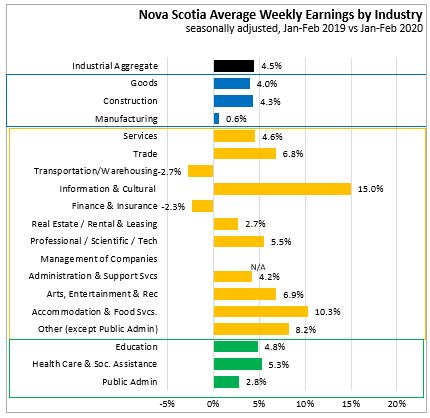
EMPLOYMENT
Nova Scotia had 424,794 payroll employees in February, a decrease of 0.2 per cent compared to last month, and up 1.5 per cent compared to last February. Canada had 16.9 million employees, a decrease of 0.2 per cent compared to last month and up 1.2 per cent compared to a year ago.
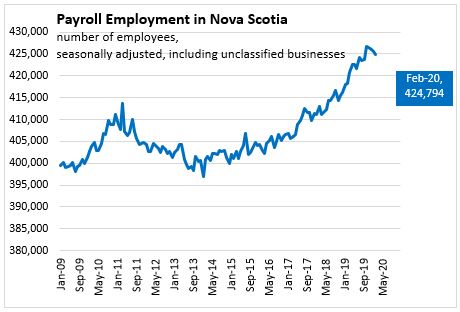
Nova Scotia's payroll employment has been trending upwards since 2017.
Compared to Jan-Feb 2019, Nova Scotia's payroll employment is up 1.7 per cent. Nationally, payroll employment is up 1.3 per cent in Jan-Feb 2020, with all provinces reporting increases except Newfoundland and Labrador and Alberta. The fastest payroll employment growth has been observed in Prince Edward Island (+2.8 per cent), followed by Quebec (+2.1 per cent) and Nova Scotia (+1.7 per cent). The slowest growth in payroll employment was observed in Newfoundland and Labrador (-0.2 per cent), Alberta (-0.3 per cent) and Saskatchewan (+0.5 per cent).
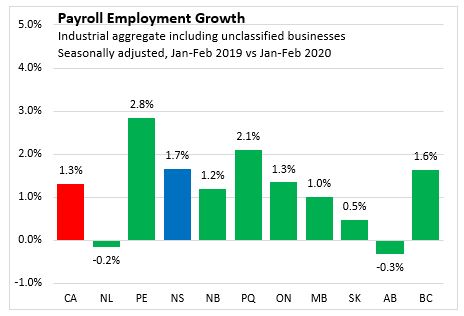
In January-February 2020, payroll employment was up 0.6 per cent in Nova Scotia's goods producing sectors. Goods sector payroll employment was up for manufacturing and construction sectors compared to January-February 2019. Service sector employment was up 2.0 per cent in January-February 2020 compared to January-February 2019. Service sector payroll employment increased the most in percentage terms in real estate/leasing (+9.6 per cent), finance and insurance (+4.9 per cent), transportation/warehousing (+3.6 per cent) and trade (+2.6 per cent) There were payroll employment declines in arts/entertainment/recreation (-4.0 per cent), management of companies (-1.3 per cent), administration/support services (-0.5 per cent), and other (except public administration) (-0.2 per cent).
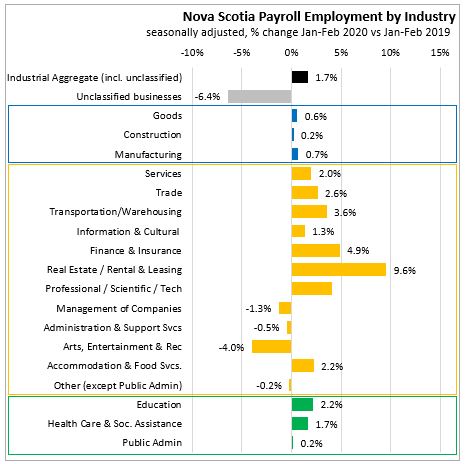
REFERENCE TABLES - (January-February 2020 vs January-February 2019)
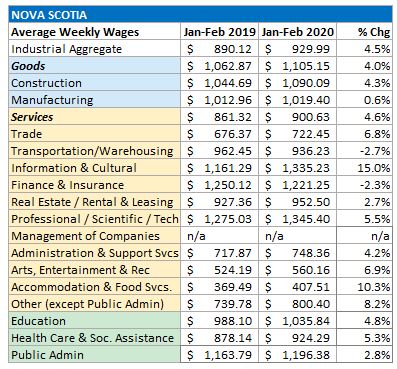
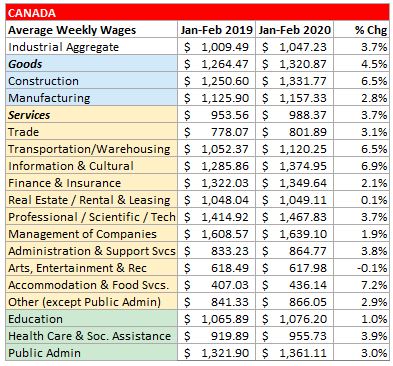
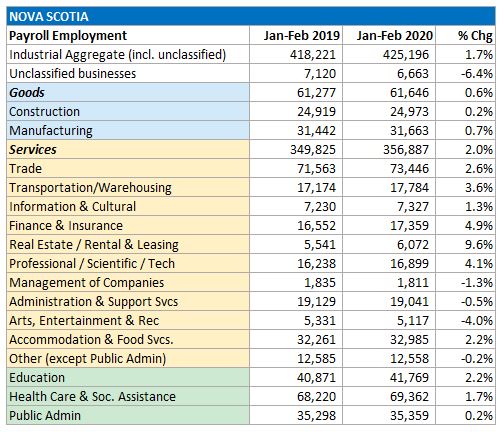
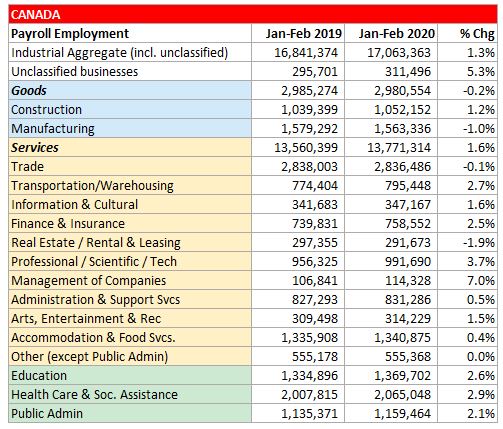
Source: Statistics Canada, Survey of Employment, Payroll, and Hours. Table 14-10-0223-01, 14-10-0222-01
<--- Return to Archive